seat adjustment BMW X5 3.0I 2002 Owners Manual
[x] Cancel search | Manufacturer: BMW, Model Year: 2002, Model line: X5 3.0I, Model: BMW X5 3.0I 2002Pages: 185, PDF Size: 2.7 MB
Page 4 of 185
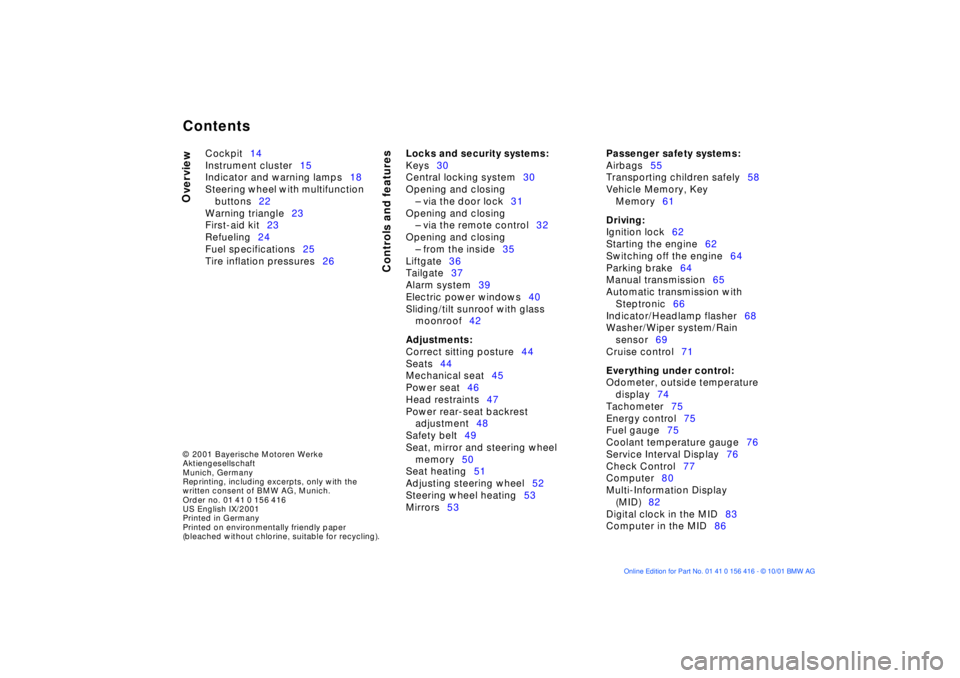
Contents
© 2001 Bayerische Motoren Werke
Aktiengesellschaft
Munich, Germany
Reprinting, including excerpts, only with the
written consent of BMW AG, Munich.
Order no. 01 41 0 156 416
US English IX/2001
Printed in Germany
Printed on environmentally friendly paper
(bleached without chlorine, suitable for recycling).
Overview
Controls and features
Cockpit14
Instrument cluster15
Indicator and warning lamps18
Steering wheel with multifunction
buttons22
Warning triangle23
First-aid kit23
Refueling24
Fuel specifications25
Tire inflation pressures26
Locks and security systems:
Keys30
Central locking system30
Opening and closing
Ð via the door lock31
Opening and closing
Ð via the remote control32
Opening and closing
Ð from the inside35
Liftgate36
Tailgate37
Alarm system39
Electric power windows40
Sliding/tilt sunroof with glass
moonroof42
Adjustments:
Correct sitting posture44
Seats44
Mechanical seat45
Power seat46
Head restraints47
Power rear-seat backrest
adjustment48
Safety belt49
Seat, mirror and steering wheel
memory50
Seat heating51
Adjusting steering wheel52
Steering wheel heating53
Mirrors53
Passenger safety systems:
Airbags55
Transporting children safely58
Vehicle Memory, Key
Memory61
Driving:
Ignition lock62
Starting the engine62
Switching off the engine64
Parking brake64
Manual transmission65
Automatic transmission with
Steptronic66
Indicator/Headlamp flasher68
Washer/Wiper system/Rain
sensor69
Cruise control71
Everything under control:
Odometer, outside temperature
display74
Tachometer75
Energy control75
Fuel gauge75
Coolant temperature gauge76
Service Interval Display76
Check Control77
Computer80
Multi-Information Display
(MID)82
Digital clock in the MID83
Computer in the MID86
Inhalt
Page 44 of 185

44n
The condition for relaxed, fatigue-free
driving is a seating position adjusted to
your needs. Together with the safety
belts and the airbags, the correct
seating position increases the passive
safety of the occupants in the case of
an accident. Therefore, observe the
following instructions, as otherwise the
protective function of the safety
systems may be impaired.
For additional information on trans-
porting children, refer to page 58.
Sitting correctly with airbags
Maintain a distance to the airbags.
Always hold the steering wheel by
the rim to keep any chance of injury to
hands or arms to an absolute minimum,
should the airbag be deployed. No one
and nothing is to come between the
airbags and the seat occupant. Do not
use the cover of the front airbag on the
front passenger side as a storage area
for objects, or as a rest for feet or
legs.<
For the location of the airbags and
additional information, refer to page 55.
Safe with safety belts
Never allow more than one person
to wear a single safety belt. Never
allow infants or small children to ride in
a passenger's lap. Avoid twisting the
belt while routing it firmly across the
pelvis and shoulder, wear it as snugly
against your body as possible. Do not
allow the belt to rest against hard or
fragile objects in your pockets. Never
route the belt across your neck, do not
run it across sharp edges and ensure
that the belt does not become caught
or jammed. Avoid wearing bulky
clothing and pull on the lap belt periodi-
cally to retension it over your shoulders.
In the event of a frontal impact, a loose
lap belt could slide over your hips,
leading to abdominal injury. In addition,
the safety belt's restraint effectiveness
is reduced if the belt is worn loosely.
Expectant mothers should always wear
their safety belts, taking care to position
the lap belt against the lower hips,
where it will not exert pressure against
the abdominal area.<
For instructions on operating the safety
belts, refer to page 49.
Observe the following before
adjusting
Never try to adjust your seat while
operating the vehicle. The seat
could respond with unexpected move-
ment, and the ensuing loss of vehicle
control could lead to an accident. Never
ride with the backrest reclined to an
extreme horizontal angle (especially
important for front passengers to
remember). Keep the backrest relatively
upright to minimize the risk of "sliding
under" the safety belt and sustaining
injury in an accident
.<
Seat adjustment>Mechanical seat adjustment, refer to
page 45
>Power seat adjustment, refer to
page 46
>Head restraints, refer to page 47
>Power rear backrest adjustment,
refer to page 48
Correct sitting posture Seats
Page 45 of 185
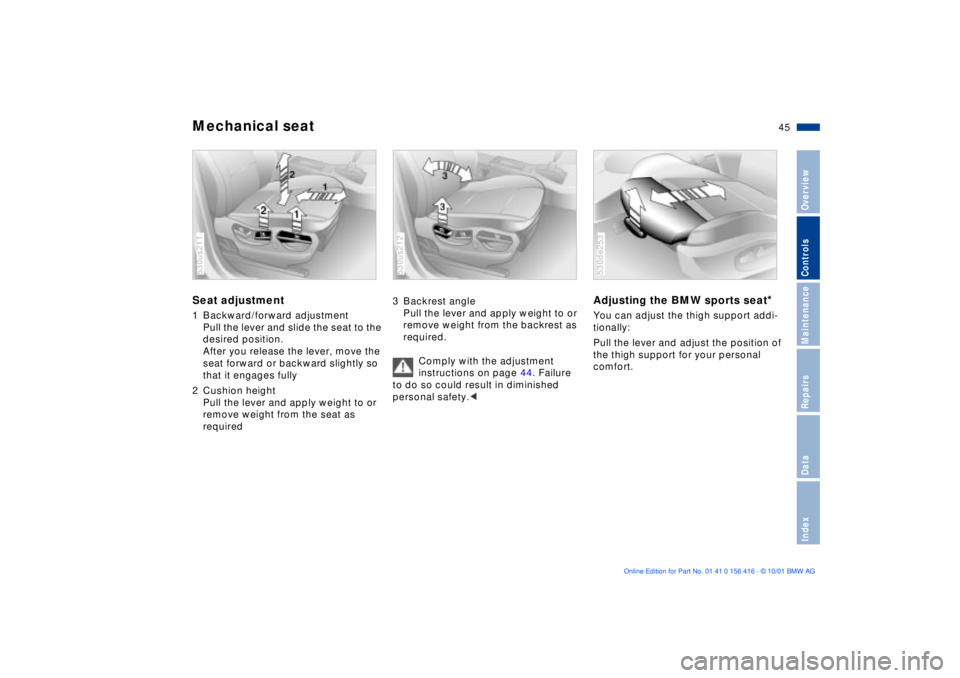
45n
OverviewControlsMaintenanceRepairsDataIndex
Mechanical seatSeat adjustment1 Backward/forward adjustment
Pull the lever and slide the seat to the
desired position.
After you release the lever, move the
seat forward or backward slightly so
that it engages fully
2 Cushion height
Pull the lever and apply weight to or
remove weight from the seat as
required 530us211
3 Backrest angle
Pull the lever and apply weight to or
remove weight from the backrest as
required.
Comply with the adjustment
instructions on page 44. Failure
to do so could result in diminished
personal safety.< 530us212
Adjusting the BMW sports seat
*
You can adjust the thigh support addi-
tionally:
Pull the lever and adjust the position of
the thigh support for your personal
comfort. 530de253
Page 46 of 185
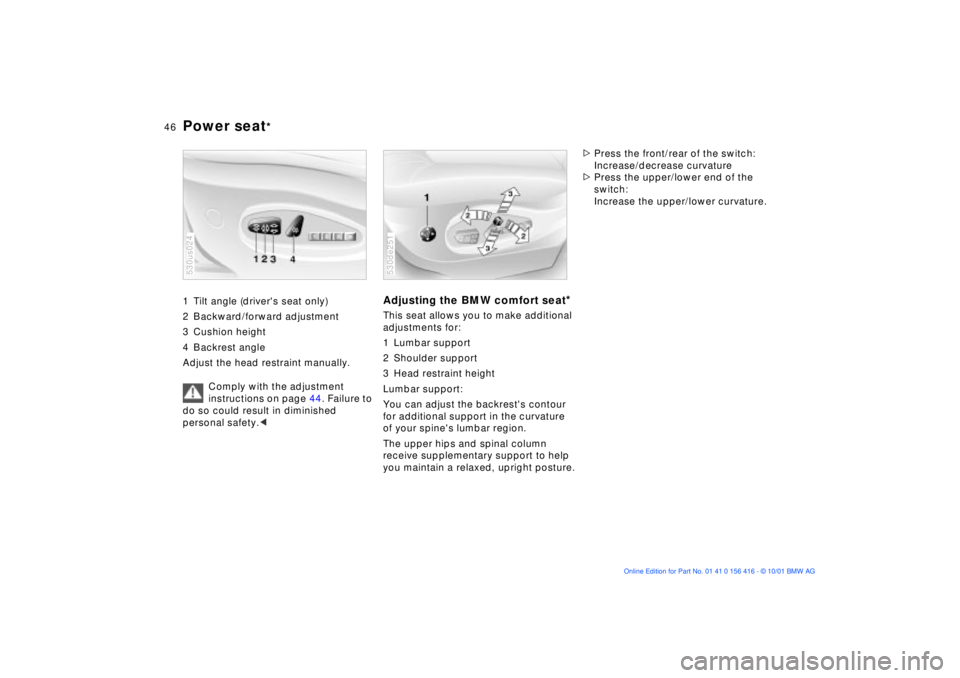
46n
Power seat
*
1 Tilt angle (driver's seat only)
2 Backward/forward adjustment
3 Cushion height
4 Backrest angle
Adjust the head restraint manually.
Comply with the adjustment
instructions on page 44. Failure to
do so could result in diminished
personal safety.< 530us024
Adjusting the BMW comfort seat
*
This seat allows you to make additional
adjustments for:
1 Lumbar support
2 Shoulder support
3 Head restraint height
Lumbar support:
You can adjust the backrest's contour
for additional support in the curvature
of your spine's lumbar region.
The upper hips and spinal column
receive supplementary support to help
you maintain a relaxed, upright posture.530de251
>Press the front/rear of the switch:
Increase/decrease curvature
>Press the upper/lower end of the
switch:
Increase the upper/lower curvature.
Page 47 of 185
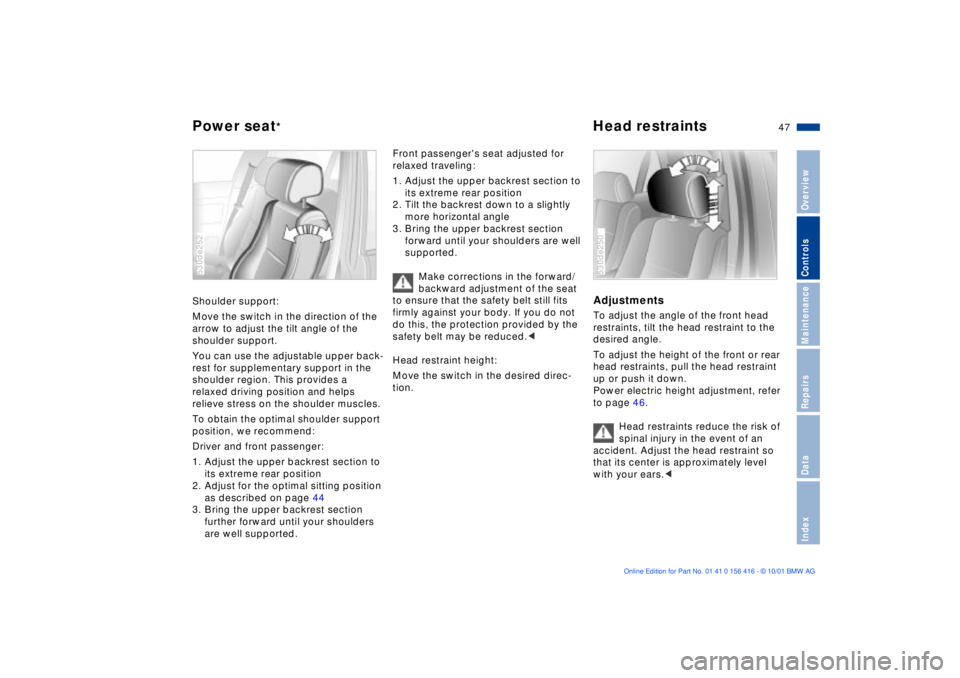
47n
OverviewControlsMaintenanceRepairsDataIndex
Power seat
*
Head restraints
Shoulder support:
Move the switch in the direction of the
arrow to adjust the tilt angle of the
shoulder support.
You can use the adjustable upper back-
rest for supplementary support in the
shoulder region. This provides a
relaxed driving position and helps
relieve stress on the shoulder muscles.
To obtain the optimal shoulder support
position, we recommend:
Driver and front passenger:
1. Adjust the upper backrest section to
its extreme rear position
2. Adjust for the optimal sitting position
as described on page 44
3. Bring the upper backrest section
further forward until your shoulders
are well supported.530de252
Front passenger's seat adjusted for
relaxed traveling:
1. Adjust the upper backrest section to
its extreme rear position
2. Tilt the backrest down to a slightly
more horizontal angle
3. Bring the upper backrest section
forward until your shoulders are well
supported.
Make corrections in the forward/
backward adjustment of the seat
to ensure that the safety belt still fits
firmly against your body. If you do not
do this, the protection provided by the
safety belt may be reduced.<
Head restraint height:
Move the switch in the desired direc-
tion.
Adjustments To adjust the angle of the front head
restraints, tilt the head restraint to the
desired angle.
To adjust the height of the front or rear
head restraints, pull the head restraint
up or push it down.
Power electric height adjustment, refer
to page 46.
Head restraints reduce the risk of
spinal injury in the event of an
accident. Adjust the head restraint so
that its center is approximately level
with your ears.< 530de250
Page 48 of 185
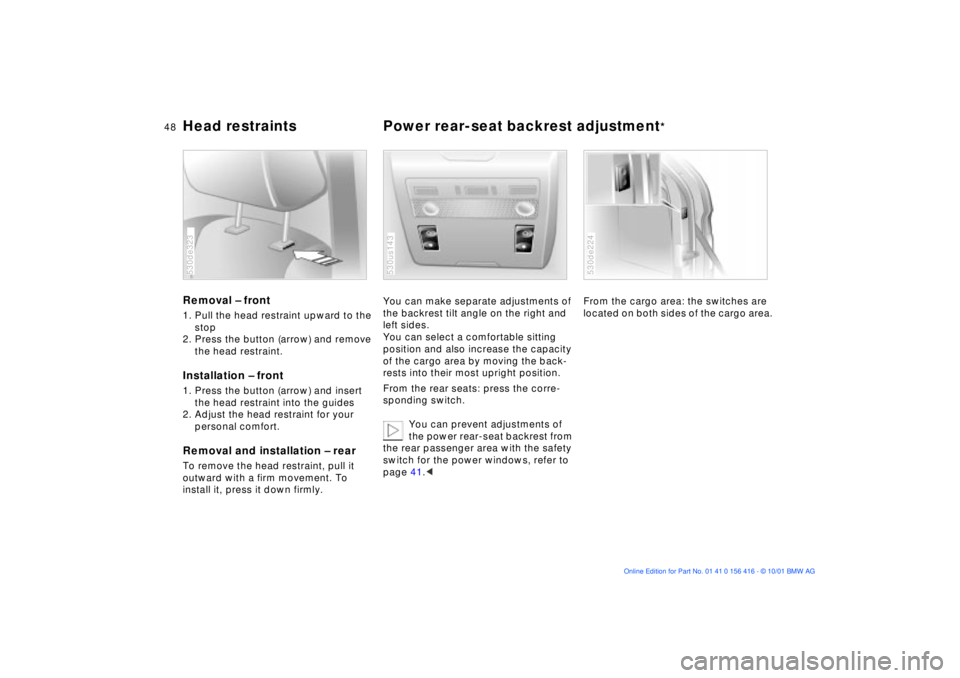
48n
Head restraints Power rear-seat backrest adjustment
*
Removal Ð front 1. Pull the head restraint upward to the
stop
2. Press the button (arrow) and remove
the head restraint.Installation Ð front 1. Press the button (arrow) and insert
the head restraint into the guides
2. Adjust the head restraint for your
personal comfort.Removal and installation Ð rearTo remove the head restraint, pull it
outward with a firm movement. To
install it, press it down firmly. 530de323
You can make separate adjustments of
the backrest tilt angle on the right and
left sides.
You can select a comfortable sitting
position and also increase the capacity
of the cargo area by moving the back-
rests into their most upright position.
From the rear seats: press the corre-
sponding switch.
You can prevent adjustments of
the power rear-seat backrest from
the rear passenger area with the safety
switch for the power windows, refer to
page 41.< 530us143
From the cargo area: the switches are
located on both sides of the cargo area. 530de224
Page 49 of 185
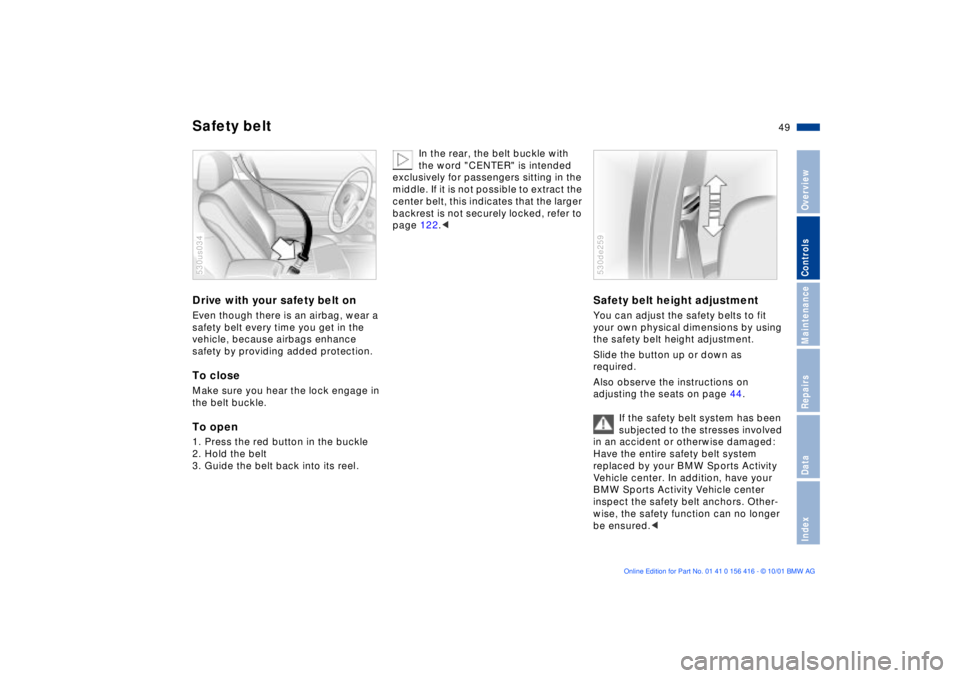
49n
OverviewControlsMaintenanceRepairsDataIndex
Safety beltDrive with your safety belt on Even though there is an airbag, wear a
safety belt every time you get in the
vehicle, because airbags enhance
safety by providing added protection.To closeMake sure you hear the lock engage in
the belt buckle.To open1. Press the red button in the buckle
2. Hold the belt
3. Guide the belt back into its reel.530us034
In the rear, the belt buckle with
the word "CENTER" is intended
exclusively for passengers sitting in the
middle. If it is not possible to extract the
center belt, this indicates that the larger
backrest is not securely locked, refer to
page 122.<
Safety belt height adjustmentYou can adjust the safety belts to fit
your own physical dimensions by using
the safety belt height adjustment.
Slide the button up or down as
required.
Also observe the instructions on
adjusting the seats on page 44.
If the safety belt system has been
subjected to the stresses involved
in an accident or otherwise damaged:
Have the entire safety belt system
replaced by your BMW Sports Activity
Vehicle center. In addition, have your
BMW Sports Activity Vehicle center
inspect the safety belt anchors. Other-
wise, the safety function can no longer
be ensured.c530de259
Page 50 of 185
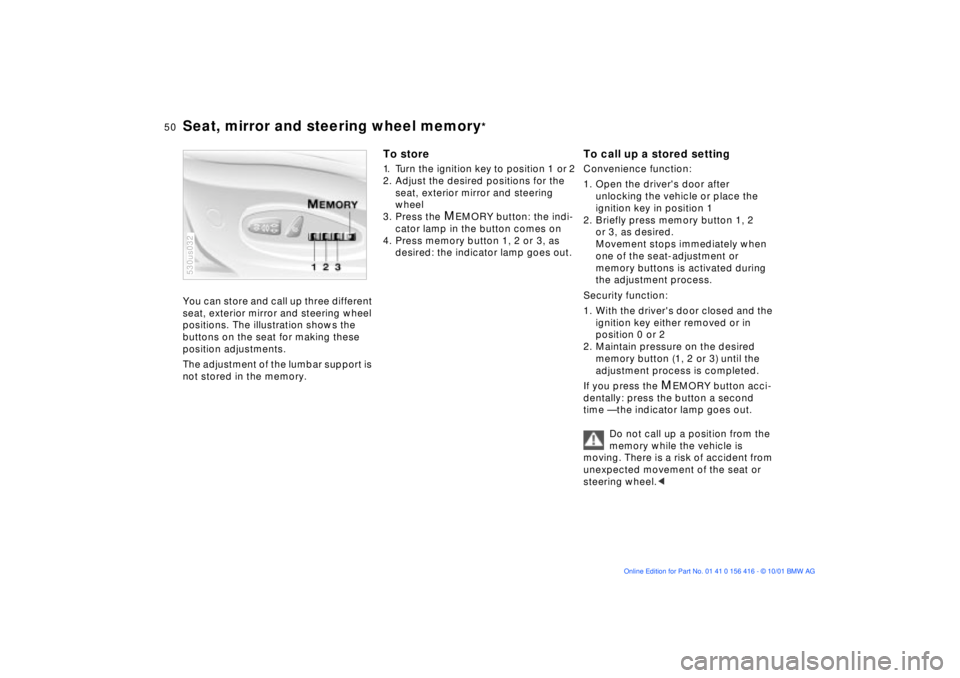
50n
Seat, mirror and steering wheel memory
*
You can store and call up three different
seat, exterior mirror and steering wheel
positions. The illustration shows the
buttons on the seat for making these
position adjustments.
The adjustment of the lumbar support is
not stored in the memory.530us032
To store 1. Turn the ignition key to position 1 or 2
2. Adjust the desired positions for the
seat, exterior mirror and steering
wheel
3. Press the
MEMORY button: the indi-
cator lamp in the button comes on
4. Press memory button 1, 2 or 3, as
desired: the indicator lamp goes out.
To call up a stored settingConvenience function:
1. Open the driver's door after
unlocking the vehicle or place the
ignition key in position 1
2. Briefly press memory button 1, 2
or 3, as desired.
Movement stops immediately when
one of the seat-adjustment or
memory buttons is activated during
the adjustment process.
Security function:
1. With the driver's door closed and the
ignition key either removed or in
position 0 or 2
2. Maintain pressure on the desired
memory button (1, 2 or 3) until the
adjustment process is completed.
If you press the
MEMORY button acci-
dentally: press the button a second
time Ñ the indicator lamp goes out.
Do not call up a position from the
memory while the vehicle is
moving. There is a risk of accident from
unexpected movement of the seat or
steering wheel.<
Page 52 of 185
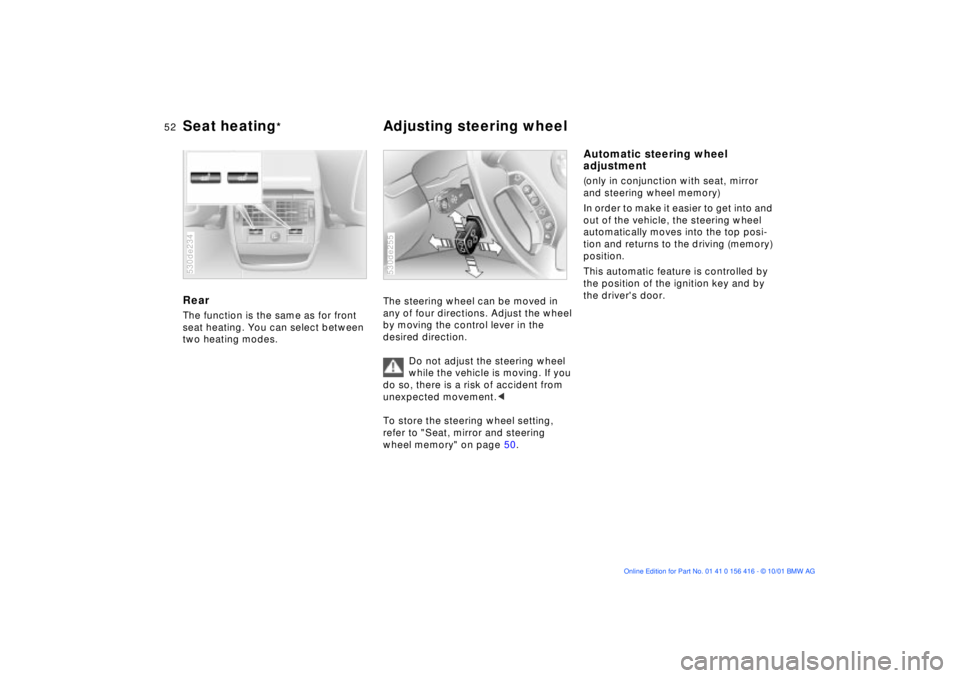
52n
Seat heating
*
Adjusting steering wheel
Rear The function is the same as for front
seat heating. You can select between
two heating modes.530de234
The steering wheel can be moved in
any of four directions. Adjust the wheel
by moving the control lever in the
desired direction.
Do not adjust the steering wheel
while the vehicle is moving. If you
do so, there is a risk of accident from
unexpected movement.<
To store the steering wheel setting,
refer to "Seat, mirror and steering
wheel memory" on page 50. 530de255
Automatic steering wheel
adjustment(only in conjunction with seat, mirror
and steering wheel memory)
In order to make it easier to get into and
out of the vehicle, the steering wheel
automatically moves into the top posi-
tion and returns to the driving (memory)
position.
This automatic feature is controlled by
the position of the ignition key and by
the driver's door.
Page 53 of 185
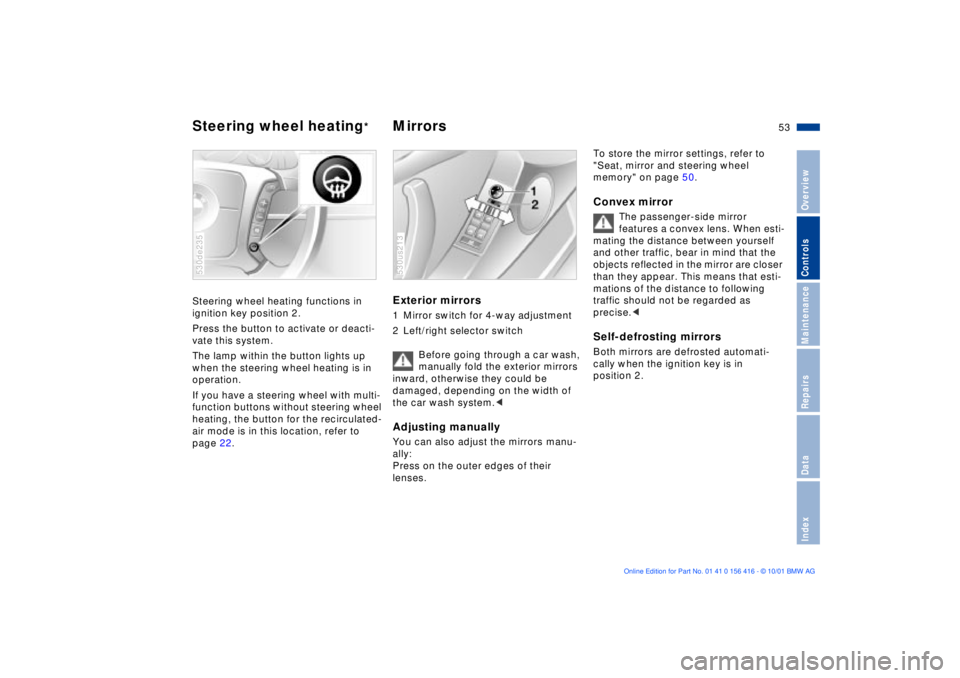
53n
OverviewControlsMaintenanceRepairsDataIndex
Steering wheel heating
*
Mirrors
Steering wheel heating functions in
ignition key position 2.
Press the button to activate or deacti-
vate this system.
The lamp within the button lights up
when the steering wheel heating is in
operation.
If you have a steering wheel with multi-
function buttons without steering wheel
heating, the button for the recirculated-
air mode is in this location, refer to
page 22.530de235
Exterior mirrors 1 Mirror switch for 4-way adjustment
2 Left/right selector switch
Before going through a car wash,
manually fold the exterior mirrors
inward, otherwise they could be
damaged, depending on the width of
the car wash system.
Press on the outer edges of their
lenses. 530us213
To store the mirror settings, refer to
"Seat, mirror and steering wheel
memory" on page 50. Convex mirror
The passenger-side mirror
features a convex lens. When esti-
mating the distance between yourself
and other traffic, bear in mind that the
objects reflected in the mirror are closer
than they appear. This means that esti-
mations of the distance to following
traffic should not be regarded as
precise.<
Self-defrosting mirrorsBoth mirrors are defrosted automati-
cally when the ignition key is in
position 2.